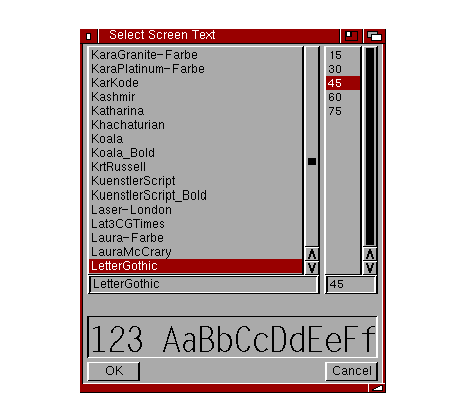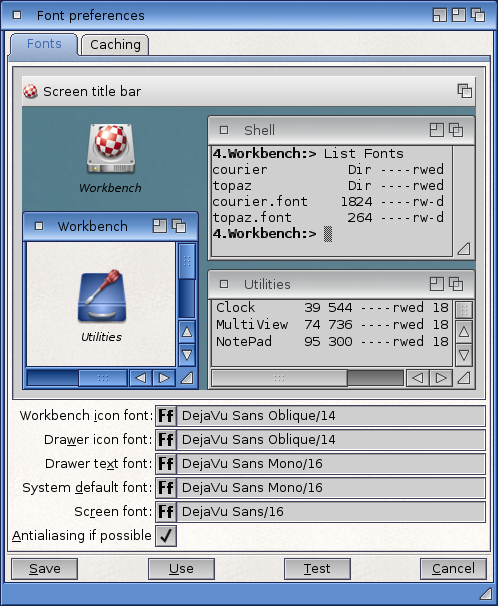Copyright (c) Hyperion Entertainment and contributors.
AmigaOS Manual: Workbench Fonts
A font or typeface is a graphic design applied to all numbers, alphabetic characters, and symbols. Using fonts, you can change the appearance of the text on your screen or on your printed documents. Because fonts can have attributes applied to them, such as italic or bold, you can use fonts to add emphasis to your text or create a particular impression in your documents: informal, scholastic, journalistic, and so forth. This chapter describes using fonts on the Amiga, including:
- Types of fonts
- Fonts
- Font requesters
- Font Preferences editor
- FixFonts
- Intellifont
Contents
Types of Fonts
Two types of fonts are available on the Amiga: bitmap and outline. Bitmap fonts are defined as a pattern of dots that compose a character. Bitmap font files are stored on disk for each size. Outline font character shapes are defined mathematically and are generated to whatever size or resolution is needed.
Topaz, the Amiga's default font, is a bitmap font stored in ROM. Other bitmap fonts, such as Helvetica, Courier, and Times are included on your Amiga disks. You can, however, create or purchase additional bitmap and outline fonts.
When choosing a font, you also specify a size in pixels, which describes the height of a character. After you have selected a font, the available sizes for it are displayed in a scroll box in a font requester. Higher numbers represent larger fonts. The maximum size allowable is 124 points.
You can use available font sizes or enter a new size. The Amiga can scale both bitmap and outline fonts to a specified size. However, scaled bitmap fonts often appear distorted.
Using Bitmap Fonts
Although bitmap fonts produce acceptable screen displays, their resolution is usually too low for high quality printouts.
Bitmap scaling stretches or squeezes the bitmap pattern, causing scaled bitmap fonts to appear distorted. If you enter a size that is not listed for a bitmap font, try to double an available size or cut an available size in half to preserve the font's proportions. For example, to produce a font between an 18 and 24 point Helvetica, use 22 since it is twice the height of the existing 11 point font. Fonts can also be scaled with the Fonts Preferences editor described on page 8-5.
Some application programs include their own fonts, font management utilities, or font scaling technology. These may use the Amiga's fonts and font technology. Read the application's manual carefully to learn how to produce the fonts you need.
Using Outline Fonts
Outline fonts are available on Amiga systems with Release 2 and higher system software. The Amiga uses Agfa Compugraphic Intellifont® technology that is managed through the Intellifont utility, described in this chapter. Compugraphic fonts for MS-DOS computers can be purchased and used on the Amiga.
Because of their large size and memory requirements, outline fonts are best suited to expanded systems equipped with hard disks. You can use them with floppy disk systems, but you may need to delete items from the Workbench backup disk to make room for them.
Outline fonts can be printed at the highest resolution of your printer, typically better than screen resolution. Outline fonts do not have separate files for each point size; instead, outline fonts are mathematically generated as required. As a result it can take longer on the first try to access an outline font than a bitmap font.
Using Proportional and Non-proportional Fonts
Both bitmap and outline fonts can be proportional or non-proportional. Proportional fonts are those in which each character occupies only the amount of space it actually needs. For example, a w character uses more space than an i character. These fonts are used to display normal text. Non-proportional fonts, also called monospaced fonts, are those in which each character occupies the same amount of horizontal space. Such fonts are easier to handle when creating numeric tables.
Fonts
On the Amiga, fonts are stored in FONTS, which can be a drawer or disk. On a hard drive system, the FONTS: directory is typically on the SYS: partition. For floppy-only systems, fonts are contained on your Fonts disk or in a Fonts drawer on your system floppy disk set. For those familiar with AmigaDOS, you can use the ASSIGN command to add disks or drawers to the FONTS: search path.
For every font you find in FONTS:, there is a file named fontname.font. For bitmap fonts there is also a subdirectory named fontname in which the file names are numbers corresponding to the font size this file contains. For outline fonts, each has a second file named fontname.otag and a file in the subdirectory _bullets_outlines named fontname.type.
Font Requester
A Font requester, shown Figure 8-1, allows you to change your font and font sizes. The standard Amiga font requester is used by the Font Preferences editor and by some applications.
The Amiga font requester window displays the available fonts and corresponding point sizes in adjacent scroll boxes. The name of the selected front and current point size are displayed in gadgets beneath the scroll boxes.
Underneath the text gadgets, a display box shows a sample of the selected font and its size. Tall fonts may not fit within the box. Drag the font requester's sizing gadget to the right to show more of the characters in the font.
Selecting a new font name in the requester does not change the current font size. If the newly selected font does not exist in the current size, it is scaled to that size. Remember that bitmap fonts can appear rough or distorted when scaled. For better quality, select one on the font's existing sizes. If the new font is an outline font, there is a delay while the new font is generated.
The Amiga font requester has a Control menu with six items:
| Last Font | Moves through the displayed font list backwards. |
| Next Font | Moves through the displayed font list forwards. |
| Restore | Recalls the font and size selected when the requester opened. |
| Rescan Disk | Looks through the FONTS: search path for newly added fonts. |
| OK | Uses the displayed font. The same as using the corresponding gadget. |
| Cancel | Restores the original setting. The same as using the corresponding gadget. |
The keyboard shortcuts for these menu items do not work when one of the text gadgets is selected.
Font Preferences Editor
The Font Preferences editor, illustrated in Figure 8-2, allows you to choose the style and size of fonts that the Amiga uses for its user interface.
| Note |
|---|
| Many applications choose their own fonts and are not affected by your choices in the Font editor. |

